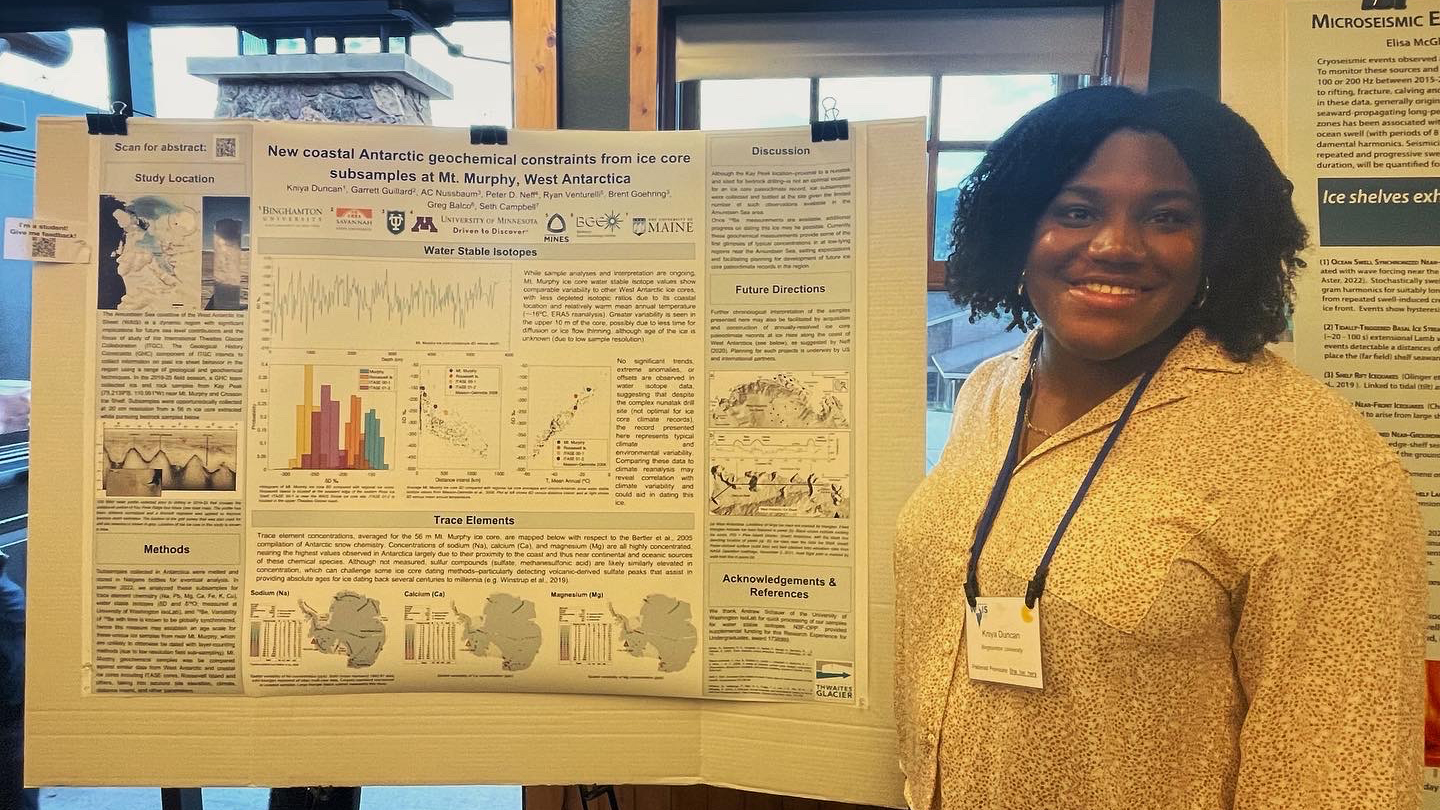On ice: Research opportunities give undergrad a head start in polar science

Kniya Duncan hasn’t been to Antarctica — yet.
But the Binghamton University junior has studied ice from the Earth’s southernmost continent, sifting data for clues as to when it was formed. A summer research experience for undergraduates (REU) at Tulane University, in collaboration with the University of Minnesota, gave her a head start toward her future career as a polar scientist.
During the project, connected with the International Thwaites Glacier Collaboration, Duncan examined data from ice cores taken on the Antarctic coast. Ice cores are exactly what the name implies: long tubes of ice, created by drilling into the top of a glacier, Duncan explained.
Unlike rock, ice forms quickly and can give insight into climate shifts over the preceding centuries, Duncan said. Understanding these shifts is increasingly important in an era of climate change.
“We’re able to take an ice core and see what’s going on in the environment. Whatever is happening in the air will be deposited in the ice,” she said.
Duncan worked online for the first two weeks of the project, and then spent a month conducting research at Tulane, alongside a lab mate. Another three weeks of remote data analysis followed.
What the data ultimately showed was in line with other information already available on coastal ice cores. While that might not seem exciting at first glance, data such as these comprise an important part of scientific research, Duncan explained. Coastal ice cores of this type are rare; most ice core research in Antarctica is conducted inland.
In short, a firm foundation of data allows researchers to determine whether future results are unusual, and what those unusual results might mean, she said.
“It will act as preliminary data for future full ice cores because we didn’t get anything crazy. You don’t want crazy results in science all the time,” she said.
Building connections
A Queens native, Duncan first discovered her interest in Earth science after taking a class in high school.
“I had been debating doing chemistry or biology in college, and then I took Earth science and it was, ‘Nope, this is what I want to do. It’s rocks for life,’” she recounted. “From then, I’ve just been hooked.”
She spent her first year as a college student at SUNY New Paltz, before transferring to Binghamton as a sophomore. As a first-year student, she interviewed several people working in fields that interested her for a class assignment, including University of Minnesota glaciologist Peter Neff after seeing his content on TikTok, she said. After the interview, they stayed in touch; when she mentioned that she was looking for summer research opportunities, he offered her the one at Tulane. The REU opportunity was initially planned in the summer of 2021, but the pandemic and National Science Foundation funding pushed it off for a year.
Neff introduced her to Assistant Professor of Geological Sciences and Environmental Studies Molly Patterson, a fellow polar scientist conducting research on the Antarctic ice sheet. Duncan’s mentorship experiences have continued to lead her to new connections and opportunities, such as the conference on the West Antarctic Ice Sheet she attended in late September; the youngest person there, Duncan presented a poster on their findings from Tulane.
Students interested in research shouldn’t be afraid to reach out to scientists in their field, she advised.
“If you’re interested in somebody’s work or something they posted online, just reach out to them. Talk to them, message them,” she said. “Even if they can’t help you, someone who they know may be able to.”
A major focus for Antarctic and Southern Ocean research right now is to understand past changes to ice sheets over a range of timescales to better understand how these dynamics will play out in the future, Patterson said. Under Patterson’s mentorship, Duncan is conducting research associated with International Ocean Drilling Expedition 374 on geological records recovered from the Ross Sea region of the Antarctic. With that and her REU experience over the summer, Duncan is getting hands-on research experience with different types of paleoclimate archives.
“The experience with working on archives that focus on ice dynamic processes over the range of timescales is going to provide her with such an amazing foundation of knowledge and hopefully an appreciation for thinking about processes over different timescales that will set her apart from her peers and make her an extremely competitive applicant for graduate school,” Patterson said. “Her amazing attitude and work ethic also make her an absolute joy to work with.”
Duncan hopes to conduct research in Antarctica herself someday and inspire the next generation of geoscientists fascinated by ancient ice.
“Being a Black woman in geology is tough as it is, but being a Black woman in polar science is even tougher because there are so few of us,” she reflected. “I’m very thankful for how far I’ve gotten as a young Black woman in geoscience. I hope that, one day, the people behind me can look to me and say, ‘Wow! She was able to accomplish this. I should be able to accomplish this, too.’”
